Alternative payment methods
Localization
Winning in Asia
August 14, 2025•7 min
Asia’s gaming market isn’t just growing; it’s evolving fast, with mobile leading the way and local payment preferences shaping the path forward.
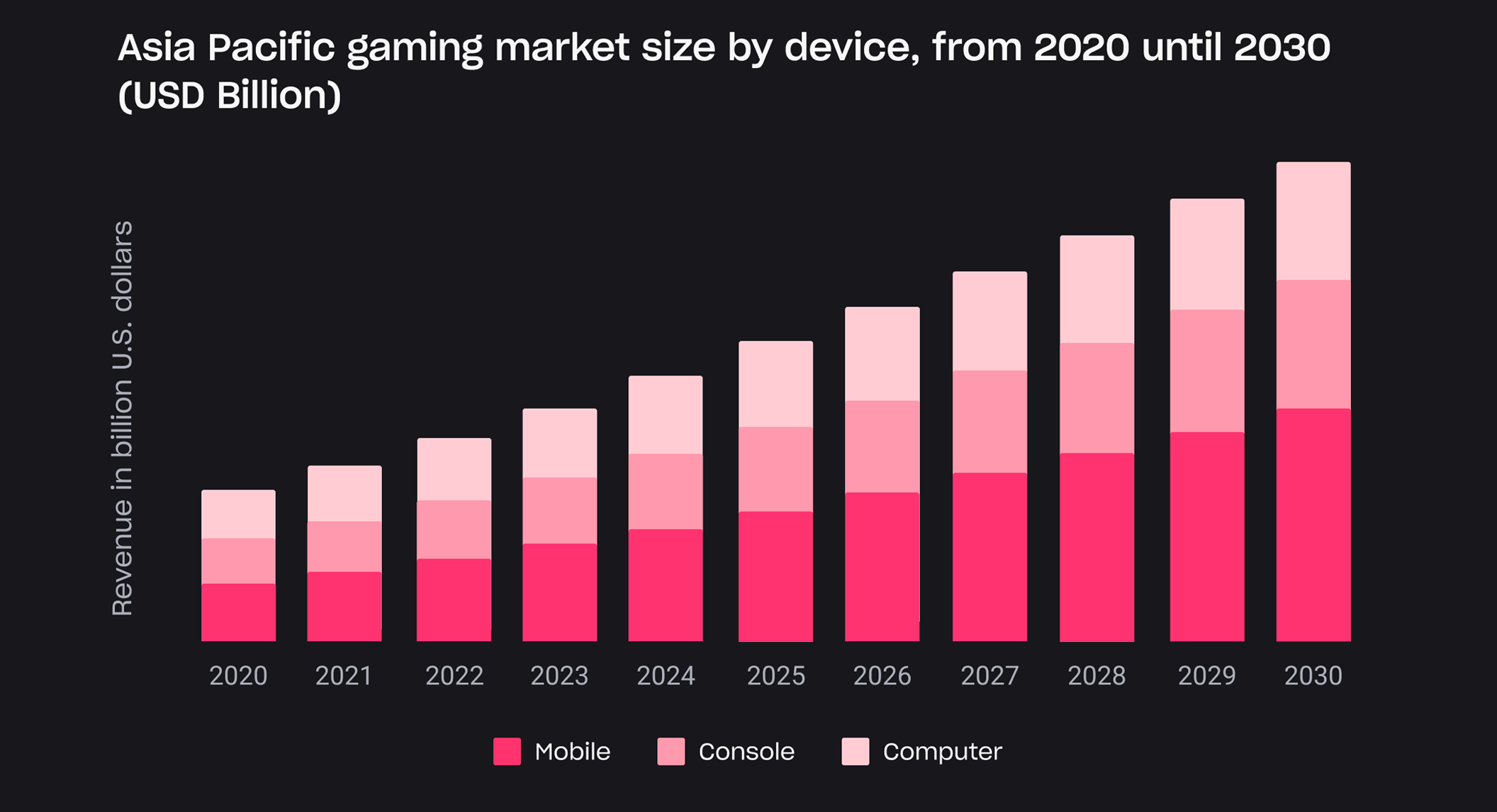 Valued at $136.5 billion in 2023 and projected to expand at 10.9% CAGR through 2030, the region offers enormous opportunities but also unique challenges. From Indonesia’s mobile-first surge to Japan’s hybrid spending culture, success increasingly depends on getting payments right at the local level.
In this article, we break down what makes Asia’s gaming economies so dynamic, and how developers can unlock real growth by supporting the payment methods players already trust. Solutions like Xsolla Payments help bridge gaps, enabling more seamless monetization across borders.
These markets are small today but growing fast. Increased internet access, rising smartphone usage, and the growth of local gaming communities are driving the adoption of mobile games. Esports and competitive gaming are rapidly gaining popularity, particularly in Vietnam and the Philippines.
Valued at $136.5 billion in 2023 and projected to expand at 10.9% CAGR through 2030, the region offers enormous opportunities but also unique challenges. From Indonesia’s mobile-first surge to Japan’s hybrid spending culture, success increasingly depends on getting payments right at the local level.
In this article, we break down what makes Asia’s gaming economies so dynamic, and how developers can unlock real growth by supporting the payment methods players already trust. Solutions like Xsolla Payments help bridge gaps, enabling more seamless monetization across borders.
These markets are small today but growing fast. Increased internet access, rising smartphone usage, and the growth of local gaming communities are driving the adoption of mobile games. Esports and competitive gaming are rapidly gaining popularity, particularly in Vietnam and the Philippines.
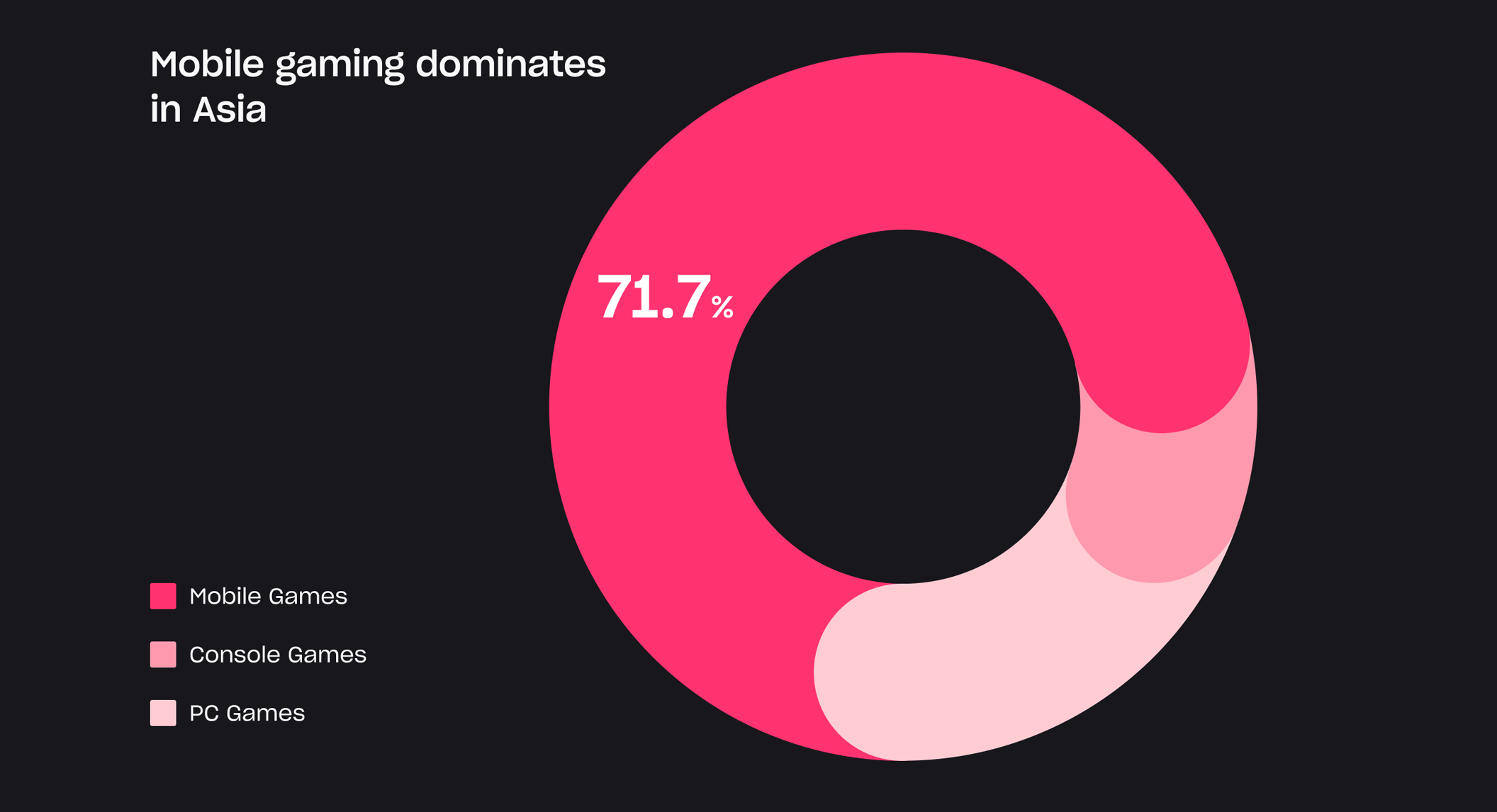 It's no surprise that Xsolla Payments now includes six new local, player-popular payment methods in Asia. This is a strategic advantage for developers looking to grow their game in one of the world's hottest gaming markets.
It's no surprise that Xsolla Payments now includes six new local, player-popular payment methods in Asia. This is a strategic advantage for developers looking to grow their game in one of the world's hottest gaming markets.
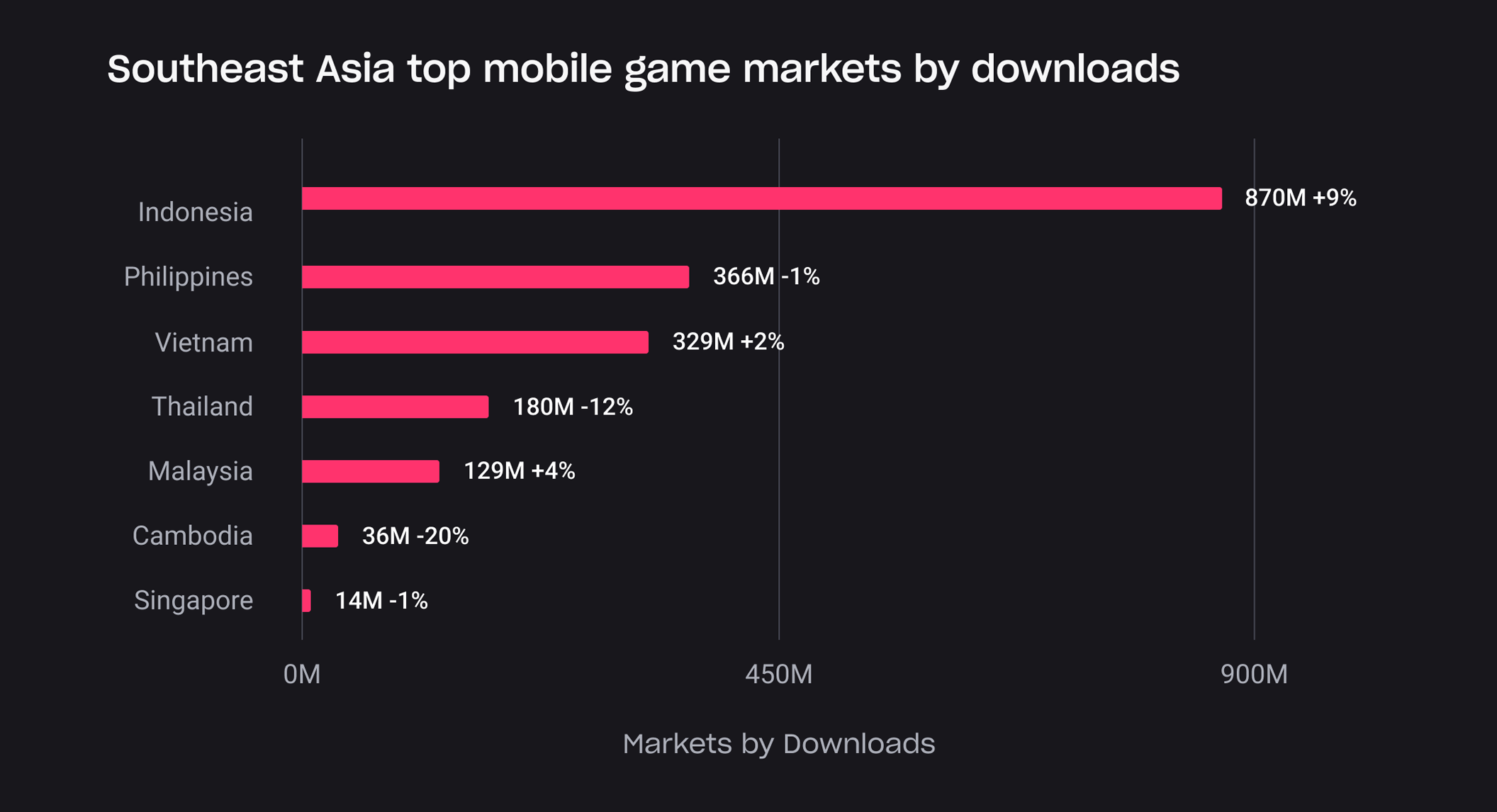 Indonesia holds the largest share of the mobile gaming market in Southeast Asia. Understandable, given a young, mobile-first population with widespread access to smartphones. The significant role that esports play, backed by government support through programs like Baparekraf Game Primestability, further bolsters the industry's growth. This combination of access, youth, and infrastructure, along with the government's commitment, continues to drive Indonesia’s dominance.
Singapore: Fastest growth, strong infrastructure
While Singapore’s overall market share is smaller, it’s growing quickly, with a projected 20% annual growth rate through 2029. As a regional technology hub, it’s home to major players like Ubisoft, Riot Games, and Bandai Namco. Singapore's robust 5G coverage, coupled with investment in cloud gaming and a stable business environment, positions it as a key hub for development and publishing.
Thailand: Esports are a national priority
Indonesia holds the largest share of the mobile gaming market in Southeast Asia. Understandable, given a young, mobile-first population with widespread access to smartphones. The significant role that esports play, backed by government support through programs like Baparekraf Game Primestability, further bolsters the industry's growth. This combination of access, youth, and infrastructure, along with the government's commitment, continues to drive Indonesia’s dominance.
Singapore: Fastest growth, strong infrastructure
While Singapore’s overall market share is smaller, it’s growing quickly, with a projected 20% annual growth rate through 2029. As a regional technology hub, it’s home to major players like Ubisoft, Riot Games, and Bandai Namco. Singapore's robust 5G coverage, coupled with investment in cloud gaming and a stable business environment, positions it as a key hub for development and publishing.
Thailand: Esports are a national priority
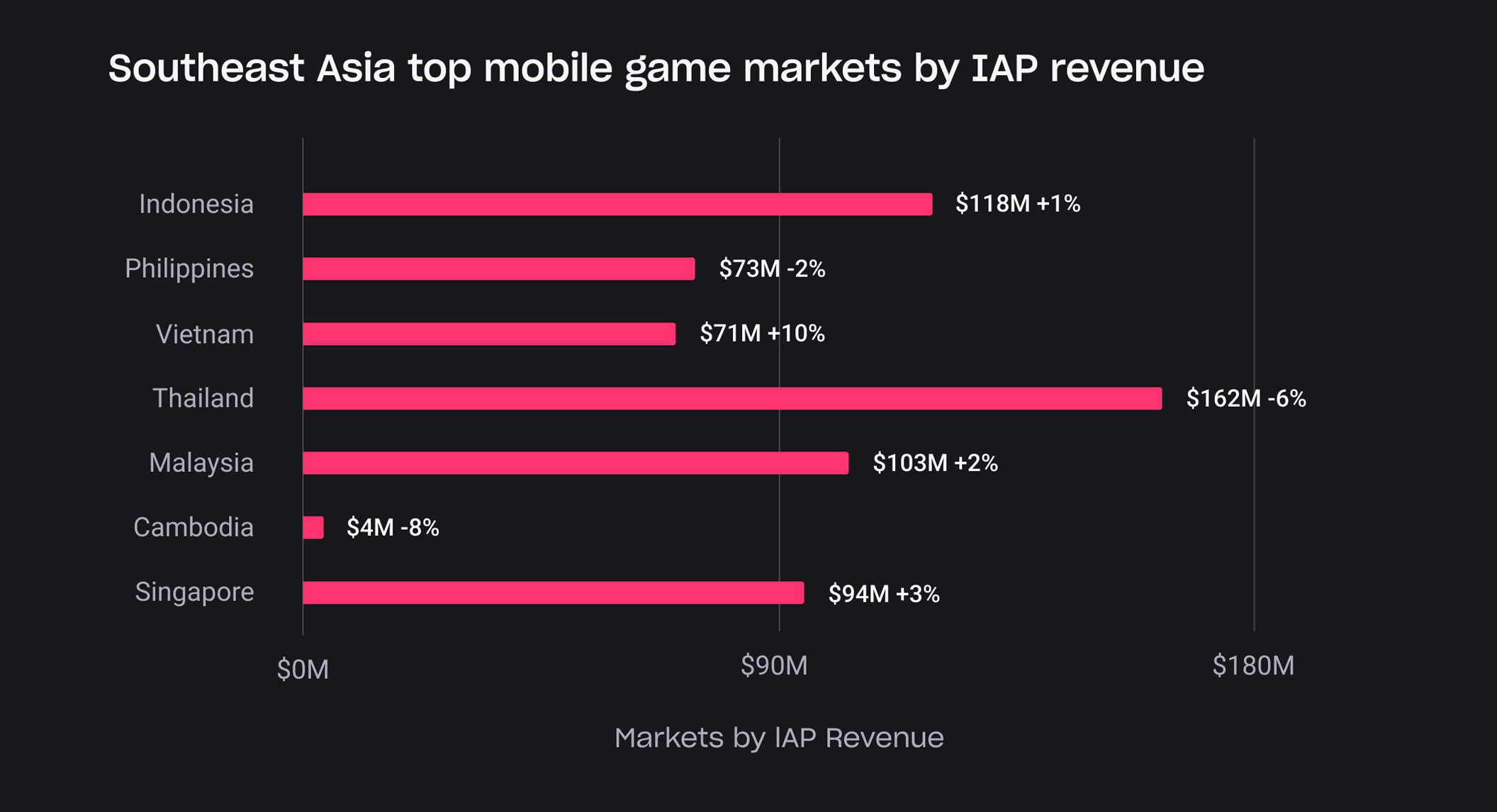 Thailand treats gaming seriously. Consumers are officially recognizing esports as a sport, and the government supports gamification through initiatives such as the Digital Economy Promotion Agency (DEPA). This formal backing has drawn investors and boosted grassroots engagement.
Malaysia: Built for mobile gaming
Malaysia boasts one of the highest smartphone penetration rates in the region, paired with a maturing esports ecosystem. Local studios are active, and player communities are thriving, making it a strong contributor to the regional mobile scene.
Japan: Console still rules, but mobile grows quietly
Japan’s mobile segment behaves differently. Console gaming remains the dominant choice among younger players, with 72% preferring it, primarily due to parental influence and a strong emphasis on game culture. However, highly game-engaged youth flock to esports, VTubers, and game streaming, with 46% participating in competitive play. Parental attitudes significantly shape this ecosystem: most are gamers themselves and tend to favor household regulation over government controls.
Vietnam, Philippines, Cambodia, and Brunei: Quiet climbers
These markets are small today but growing fast. Increased internet access, rising smartphone usage, and a surge in local gaming communities are driving the adoption of mobile games. Esports and competitive gaming are gaining popularity rapidly, particularly in Vietnam and the Philippines.
Thailand treats gaming seriously. Consumers are officially recognizing esports as a sport, and the government supports gamification through initiatives such as the Digital Economy Promotion Agency (DEPA). This formal backing has drawn investors and boosted grassroots engagement.
Malaysia: Built for mobile gaming
Malaysia boasts one of the highest smartphone penetration rates in the region, paired with a maturing esports ecosystem. Local studios are active, and player communities are thriving, making it a strong contributor to the regional mobile scene.
Japan: Console still rules, but mobile grows quietly
Japan’s mobile segment behaves differently. Console gaming remains the dominant choice among younger players, with 72% preferring it, primarily due to parental influence and a strong emphasis on game culture. However, highly game-engaged youth flock to esports, VTubers, and game streaming, with 46% participating in competitive play. Parental attitudes significantly shape this ecosystem: most are gamers themselves and tend to favor household regulation over government controls.
Vietnam, Philippines, Cambodia, and Brunei: Quiet climbers
These markets are small today but growing fast. Increased internet access, rising smartphone usage, and a surge in local gaming communities are driving the adoption of mobile games. Esports and competitive gaming are gaining popularity rapidly, particularly in Vietnam and the Philippines.
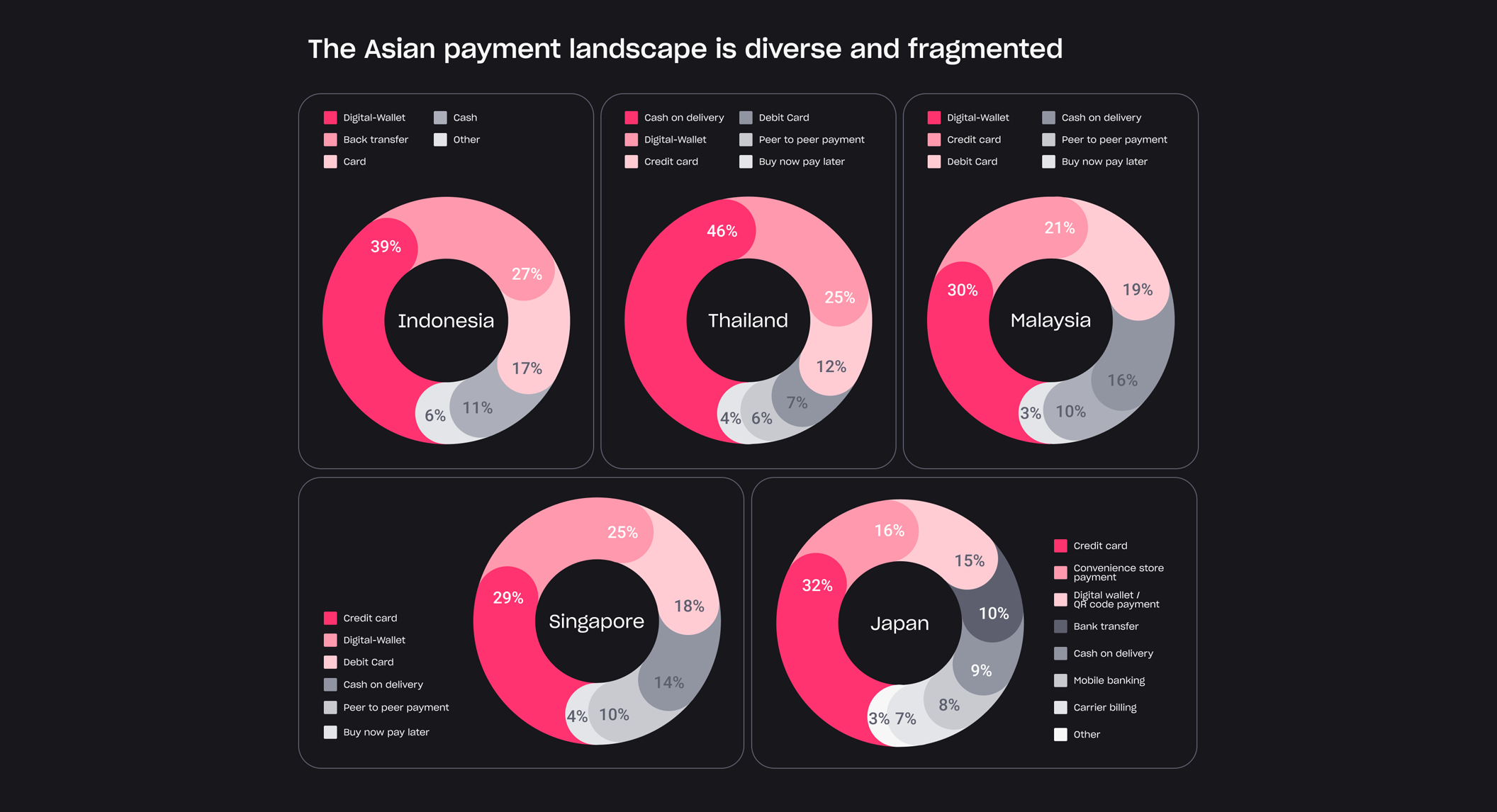 It's easy to see why Asia's cross-border monetization demands more than just translation, and why developers need a more tailored approach to payments across the region.
It's easy to see why Asia's cross-border monetization demands more than just translation, and why developers need a more tailored approach to payments across the region.
 Localized payment options don't just make checkout easier or players' purchase experience more enjoyable; they increase gamer trust, boost conversions, and increase retention. As Asia's gaming market continues its upward trajectory, partnering with a global game monetization expert like Xsolla isn’t just smart, it’s essential for game studios aiming to scale.
Talk to one of Xsolla’s monetization experts or set up an Xsolla Publisher Account to see our approach to localization in action and get more details on localizing your game and reaching new customers throughout Asia.
Localized payment options don't just make checkout easier or players' purchase experience more enjoyable; they increase gamer trust, boost conversions, and increase retention. As Asia's gaming market continues its upward trajectory, partnering with a global game monetization expert like Xsolla isn’t just smart, it’s essential for game studios aiming to scale.
Talk to one of Xsolla’s monetization experts or set up an Xsolla Publisher Account to see our approach to localization in action and get more details on localizing your game and reaching new customers throughout Asia.
 Valued at $136.5 billion in 2023 and projected to expand at 10.9% CAGR through 2030, the region offers enormous opportunities but also unique challenges. From Indonesia’s mobile-first surge to Japan’s hybrid spending culture, success increasingly depends on getting payments right at the local level.
In this article, we break down what makes Asia’s gaming economies so dynamic, and how developers can unlock real growth by supporting the payment methods players already trust. Solutions like Xsolla Payments help bridge gaps, enabling more seamless monetization across borders.
These markets are small today but growing fast. Increased internet access, rising smartphone usage, and the growth of local gaming communities are driving the adoption of mobile games. Esports and competitive gaming are rapidly gaining popularity, particularly in Vietnam and the Philippines.
Valued at $136.5 billion in 2023 and projected to expand at 10.9% CAGR through 2030, the region offers enormous opportunities but also unique challenges. From Indonesia’s mobile-first surge to Japan’s hybrid spending culture, success increasingly depends on getting payments right at the local level.
In this article, we break down what makes Asia’s gaming economies so dynamic, and how developers can unlock real growth by supporting the payment methods players already trust. Solutions like Xsolla Payments help bridge gaps, enabling more seamless monetization across borders.
These markets are small today but growing fast. Increased internet access, rising smartphone usage, and the growth of local gaming communities are driving the adoption of mobile games. Esports and competitive gaming are rapidly gaining popularity, particularly in Vietnam and the Philippines.
 It's no surprise that Xsolla Payments now includes six new local, player-popular payment methods in Asia. This is a strategic advantage for developers looking to grow their game in one of the world's hottest gaming markets.
It's no surprise that Xsolla Payments now includes six new local, player-popular payment methods in Asia. This is a strategic advantage for developers looking to grow their game in one of the world's hottest gaming markets.
Localization where it counts
Asia’s mobile gaming market is booming, with each country showing distinct drivers behind its growth. A close examination of the regional breakdown in 2024 reveals clear leaders and trends that are shaping the landscape. Indonesia: Leading with 35% market share Indonesia holds the largest share of the mobile gaming market in Southeast Asia. Understandable, given a young, mobile-first population with widespread access to smartphones. The significant role that esports play, backed by government support through programs like Baparekraf Game Primestability, further bolsters the industry's growth. This combination of access, youth, and infrastructure, along with the government's commitment, continues to drive Indonesia’s dominance.
Singapore: Fastest growth, strong infrastructure
While Singapore’s overall market share is smaller, it’s growing quickly, with a projected 20% annual growth rate through 2029. As a regional technology hub, it’s home to major players like Ubisoft, Riot Games, and Bandai Namco. Singapore's robust 5G coverage, coupled with investment in cloud gaming and a stable business environment, positions it as a key hub for development and publishing.
Thailand: Esports are a national priority
Indonesia holds the largest share of the mobile gaming market in Southeast Asia. Understandable, given a young, mobile-first population with widespread access to smartphones. The significant role that esports play, backed by government support through programs like Baparekraf Game Primestability, further bolsters the industry's growth. This combination of access, youth, and infrastructure, along with the government's commitment, continues to drive Indonesia’s dominance.
Singapore: Fastest growth, strong infrastructure
While Singapore’s overall market share is smaller, it’s growing quickly, with a projected 20% annual growth rate through 2029. As a regional technology hub, it’s home to major players like Ubisoft, Riot Games, and Bandai Namco. Singapore's robust 5G coverage, coupled with investment in cloud gaming and a stable business environment, positions it as a key hub for development and publishing.
Thailand: Esports are a national priority
 Thailand treats gaming seriously. Consumers are officially recognizing esports as a sport, and the government supports gamification through initiatives such as the Digital Economy Promotion Agency (DEPA). This formal backing has drawn investors and boosted grassroots engagement.
Malaysia: Built for mobile gaming
Malaysia boasts one of the highest smartphone penetration rates in the region, paired with a maturing esports ecosystem. Local studios are active, and player communities are thriving, making it a strong contributor to the regional mobile scene.
Japan: Console still rules, but mobile grows quietly
Japan’s mobile segment behaves differently. Console gaming remains the dominant choice among younger players, with 72% preferring it, primarily due to parental influence and a strong emphasis on game culture. However, highly game-engaged youth flock to esports, VTubers, and game streaming, with 46% participating in competitive play. Parental attitudes significantly shape this ecosystem: most are gamers themselves and tend to favor household regulation over government controls.
Vietnam, Philippines, Cambodia, and Brunei: Quiet climbers
These markets are small today but growing fast. Increased internet access, rising smartphone usage, and a surge in local gaming communities are driving the adoption of mobile games. Esports and competitive gaming are gaining popularity rapidly, particularly in Vietnam and the Philippines.
Thailand treats gaming seriously. Consumers are officially recognizing esports as a sport, and the government supports gamification through initiatives such as the Digital Economy Promotion Agency (DEPA). This formal backing has drawn investors and boosted grassroots engagement.
Malaysia: Built for mobile gaming
Malaysia boasts one of the highest smartphone penetration rates in the region, paired with a maturing esports ecosystem. Local studios are active, and player communities are thriving, making it a strong contributor to the regional mobile scene.
Japan: Console still rules, but mobile grows quietly
Japan’s mobile segment behaves differently. Console gaming remains the dominant choice among younger players, with 72% preferring it, primarily due to parental influence and a strong emphasis on game culture. However, highly game-engaged youth flock to esports, VTubers, and game streaming, with 46% participating in competitive play. Parental attitudes significantly shape this ecosystem: most are gamers themselves and tend to favor household regulation over government controls.
Vietnam, Philippines, Cambodia, and Brunei: Quiet climbers
These markets are small today but growing fast. Increased internet access, rising smartphone usage, and a surge in local gaming communities are driving the adoption of mobile games. Esports and competitive gaming are gaining popularity rapidly, particularly in Vietnam and the Philippines.
Emerging player trends in Asia
Asia’s gaming market is evolving rapidly, with increasing playtime, growing esports engagement, diverse spending habits, and a rising interest in Web3. Here are 6 key insights to add to your SEA game market knowledge bank.- Playtime rebounds sharply. Gaming time grew by 53.2% YoY in 2024 across SEA-6 countries, led by Thailand and Vietnam, reversing the 2023 post-COVID decline.
- Esports dominate engagement. Over 50% of gamers in the region actively engage in esports, with competitive titles that top charts across both mobile and PC.
- Women lead in in-game spending. 30% of female gamers make game purchases — outpacing men (22%) — highlighting their growing influence in the market.
- Digital wallets are king. More than 75% of gamers prefer digital wallets, while older players lean toward cards and younger ones favor cash-based options.
- Rising interest in Web3 and play-to-earn. Play-to-earn and Web3 gaming remain strong, especially in Malaysia, Thailand, Vietnam, and the Philippines, despite slower industry growth.
- Localization, inclusion, and local IP matter. SEA gamers prioritize local language support and representation and increasingly champion locally made games, such as GigaBash and Coral Island.
Cross‑border fragmentation
Asia’s gaming ecosystem isn’t monolithic. It’s diverse; a blend of rising economies, payment cultures, and rapid mobile adoption. It's easy to see why Asia's cross-border monetization demands more than just translation, and why developers need a more tailored approach to payments across the region.
It's easy to see why Asia's cross-border monetization demands more than just translation, and why developers need a more tailored approach to payments across the region.
- Multiple currencies, languages, platforms, and purchasing behaviors can be a challenge.
- High mobile wallet and bank-transfer usage, compounded by low credit card penetration in many areas.
- Trust in local methods is key. If players don’t see their payment method, they don't complete their transaction, resulting in churn.
- Thailand: ShopeePay for wallet-based payments, K PLUS for bank-linked payments, and AIS for direct carrier billing (DCB).
- Malaysia: FPX bank transfers are the dominant payment method, with ShopeePay gaining traction.
- Singapore: A digitally mature market that favors digital wallets like ShopeePay for fast, mobile-first checkouts.
- Indonesia: Indosat is a direct carrier billing (DCB) option that supports monetization among players without cards or digital wallets.
- Japan: People here embrace digital wallets, such as MerPay, which serve nearly 17 million users.
Why Xsolla pays off in Asia
Xsolla offers full compliance and local expertise, allowing developers in Asia to monetize globally and welcome international titles locally. Included in our more than 1,000 payment methods (like digital wallets, transfers, DCBs, and bank apps), our recent entry into emerging markets like Cambodia and Indonesia resulted in eight new payment options tailored to local preferences. With Asia's CAGR around 0.2%, it's our solution's localized flexibility that translates into measurable conversions for game developers. Confronting fraud at scale High mobile usage correlates with an increased risk of fraud. Xsolla Anti-Fraud embeds risk management tools designed for mobile‑first markets. This product protects both revenue and player trust, which is crucial in regions where digital transaction fraud remains a genuine threat. Elevating player experience and lifetime value Robust marketing capabilities are built into Xsolla Payments. Features such as reward systems, tailored campaigns, and checkout experiences are optimized for local context. A smoother, localized payment flow converts casual players into paying users, driving retention and long-term value. Xsolla Payments thrives in Asia Xsolla supports over 1,000 global payment methods, offering deep regional customization Xsolla Payments supports millions of gamers across dozens of markets through partnerships, unlocking five new channels across SEA, East Asia, and the Pacific, resulting in a 9.47% user growth rate compared to 8.76% globally. Additionally, Xsolla's merchant of record services enrich studios with compliance, payment mechanics, and market intelligence.Final takeaway
 Localized payment options don't just make checkout easier or players' purchase experience more enjoyable; they increase gamer trust, boost conversions, and increase retention. As Asia's gaming market continues its upward trajectory, partnering with a global game monetization expert like Xsolla isn’t just smart, it’s essential for game studios aiming to scale.
Talk to one of Xsolla’s monetization experts or set up an Xsolla Publisher Account to see our approach to localization in action and get more details on localizing your game and reaching new customers throughout Asia.
Localized payment options don't just make checkout easier or players' purchase experience more enjoyable; they increase gamer trust, boost conversions, and increase retention. As Asia's gaming market continues its upward trajectory, partnering with a global game monetization expert like Xsolla isn’t just smart, it’s essential for game studios aiming to scale.
Talk to one of Xsolla’s monetization experts or set up an Xsolla Publisher Account to see our approach to localization in action and get more details on localizing your game and reaching new customers throughout Asia.Featured articles
Contact us
Talk to an expert
Ready to maximize revenue opportunities? Reach out to our experts and learn how to start earning more and spending less.